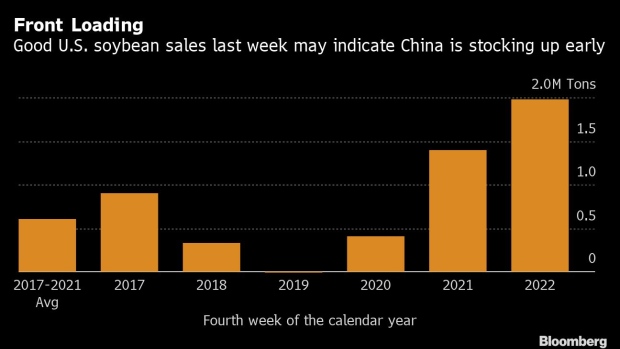Feb 3, 2022
U.S. Soybeans Are in High Demand as Brazil’s Crop Falls Short
, Bloomberg News

(Bloomberg) -- Soybean buyers stung by a smaller and slower harvest than expected in Brazil are turning to the U.S. for supply, driving up prices and threatening to worsen food inflation.
What was expected to be a record crop in Brazil is now looking far smaller, with lower yields and harvest delays due to adverse weather catching traders and end-users shorthanded. The uncertainty has driven buyers into the U.S. market. More than 110 ships have been chartered on a preliminary basis to load crops at ports in the Pacific Northwest, according to Bill Tierney, chief economist for AgResource Co. in Chicago.
The rush by physical traders and financial players has driven up futures in Chicago by 30% since early November to an eight-month high, with the premium for July contracts over November surging eight-fold. Demand for immediate delivery has pushed cash prices at elevators in the U.S. Midwest to unusually high premiums to futures. Sales for export jumped to almost 2 million tons last week, exceeding the highest analyst estimate.
The impact of higher soybean costs is set to ripple through the food supply chain at a time when global prices are near a record. It will be more expensive to feed animals, as beans are crushed into meal for livestock, chicken and pigs. It threatens to also drive up the cost of cooking oil, already boosted by record palm and canola oil.
“South America’s soybean losses put a great responsibility on the U.S., where plantings and yields will need to increase to avoid” persistent high prices, Etore Baroni, an analyst at StoneX in Brazil, said Thursday at a webinar.
It wasn’t supposed to happen this way. Chinese firms and other buyers typically look to South America for supply in the first quarter of the year, as the harvest typically begins in early January, with new-crop supplies reaching the ports weeks later. And a few months ago, all signs were for a bumper crop -- some 145 million tons in Brazil, 50 million from Argentina and 10 million in Paraguay.
Planting went well within the ideal window. But then La Nina -- bringing high temperatures and drought to key growing regions of southern Brazil and Argentina -- has damaged the crop, and dry periods are likely still ahead of us, according to the weather forecaster Maxar.
Brazil, Argentina and Paraguay will export some 20 million tons less than what was projected in December, according to analysts. Strong processing margins will keep demand for soybeans heated in Brazil, with local industries competing with foreign buyers, Baroni said.
The signs of urgent demand are clear in the rising levels of so-called basis differentials and physical prices in market hubs of Santos and New Orleans. Farmers in Brazil are being offered record prices, and ships are lining up outside the main export terminals as traders vie to secure any beans they can to fill vessels bound for China and other markets.
The basis, or premium buyers will pay above futures for beans -- in Santos is up 35% already so far this year and in New Orleans it’s $1.34 a bushel, compared with 84.5 cents a year ago.
Brazil’s soybean exports could reach 9.9 million tons in February, according to the National Association of Cereal Exporters. While that’s a record for the month and almost double from last year, when the oilseed harvest was delayed by late planting, the monthly export capacity is around 16 million, which shows that supplies are slow getting to the ports.
“We are seeing a big concern for summer, as Brazil is 20 cents higher per bushel than U.S. Gulf in June and July,” said Arlan Suderman, chief commodities economist at StoneX. “That seems to be the market telling us that they are running out of supplies and we can see more demand coming to the U.S. If this is true, this is a dramatic game changer.”
©2022 Bloomberg L.P.


